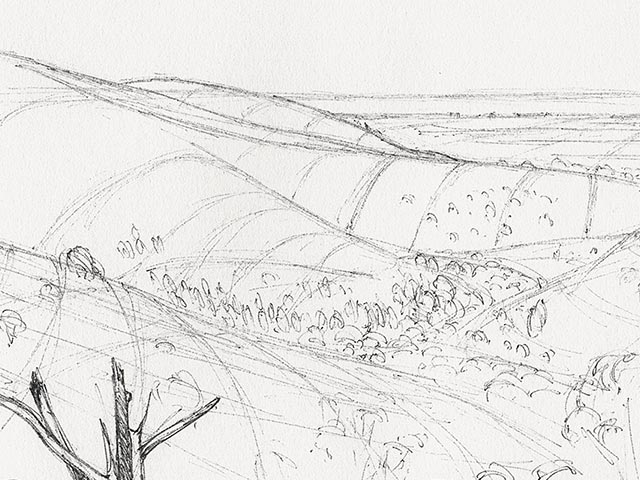
Monthly Display - March 2024 - page 1 (of 3) |
|
Following are images with brief descriptions of about twenty two artworks that hopefully explain some of my unique expressions of forms and spaces. I use the term ‘my unique expressions’, because I genuinely developed these expressions as I produced my artwork, and even though I have seen many artworks over the years (either real pieces or reproductions – whether they were produced fairly recently or from a history going back hundreds of years), I have not seen any other artist use similar expressions in similar ways. Basic Navigation:Click on an image, or a link to 'more details...', to go to a page with more details about that artwork. Once you are looking at artworks in more detail, you can use the 'prev' and 'next' links (at the top and bottom of each details page) to go to the previous or next artworks in this month's display, or return to these 3 main Monthly pages. The details pages also contain most of the text explanations found in these 3 main Monthly pages.
My Unique Expressions of Forms and SpacesI use the term ‘my unique expressions’, because I genuinely developed these expressions as I produced my artwork, and even though I have seen many artworks over the years (either real pieces or from reproductions – whether they were produced fairly recently or from a history going back hundreds of years), I have not seen any other artist use similar expressions in similar ways. I believe that my unique expressions of forms and spaces have come about mainly because I have done a lot of drawing using biros on paper, because I worked from things that were real, and because I was aware that I enjoyed seeing those real things with my stereo vision (combining images from two eyes looking at three-dimensional forms and spaces). |


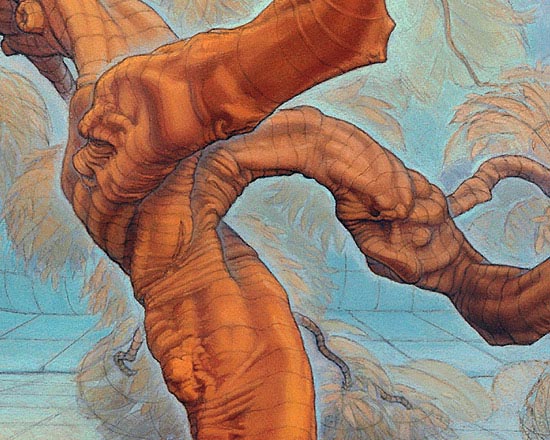
Stereo VisionMost people with two reasonably good eyes can enjoy excellent stereo vision (that is, an excellent understanding of three-dimensional forms and spaces from seeing things using their two eyes). It is something that we can easily take for granted, because it is something that we generally do extremely easily – without thinking about it. We see things that are around us from two eyes that are only a fairly short distance apart. However, the differences detected by each eye are processed in our brains to give us a sense of how close or how distant a surface may be. And the processing is so quick that we can easily process moving surfaces (like leaves fluttering in the breeze), even as we move about within our environments. That is an ability worth considering as being quite amazing in itself, and it should be appreciated more! I know from my experiments into three-dimensional photography, using two cameras, that the timing of the shutters of both cameras needs to be perfect, otherwise objects that are moving seem to display at the wrong distance to the viewer. Even a few hundredths of a second difference can make big problems in the three-dimensional capturing, so I am not sure how our brains do it! I know that our eyes and our brains don’t use shutters, but the problems I have found with using two cameras does give me an appreciation of how amazing this processing is in our brains. I am grateful that my own brain’s three-dimensional processing seems to work perfectly! Our three-dimensional vision processing was an important aspect of surviving as a more primitive primate living in dense jungles. It was crucial for survival to know exactly where close branches were and where the spaces were. I enjoy the complex three-dimensional structures that I see in the natural world, such as trees, moving foliage, fruit, interesting land forms, moving sea water, clouds moving through the sky, as well as many combinations of three-dimensional person-made objects, such as jars, shelves, pens, chairs, tables, etc.
About My Artwork, GenerallyWith my drawings and paintings, I have tried to focus on interesting things that I have experienced in the natural world. I liked the idea of getting outside and working directly from the world around me, in a similar manner to my understanding of the ways that the Impressionist and Post-Impressionist artists worked. I enjoy working directly from things that are real, and hope that working directly from real subjects somehow collects enough ‘truth’ to motivate the viewer into considering my pieces more as I had intended. I am a serious, primarily self-taught artist. I see my artwork as being a concrete expression of my human consciousness, that I am willing to present to other people. I have experimented with producing a wide range of artwork, from carefully observed studies drawn directly from life, to totally abstract pieces, but almost all are driven by a strong desire to express; to express feelings, ideas, and experiences that are personal (often deeply personal) but that I see as largely transcending social conditions – that is, the feelings, ideas and experiences of a living being that has discovered an incredible and positive world that is outside the often confusing mesh of human social interactions. I believe in the power of appreciating the so-called ‘simple pleasures’ in life, for example enjoying the spectacle and warmth of sunlight, enjoying the enormity of space within a clear night sky, enjoying the patterns seen in a sky of clouds, enjoying the organic structures observed in a tree trunk, and enjoying the movements (and displayed energy) of waves at the beach. I enjoy painting and drawing on-site, outdoors, immersed in a rich, positive sensory environment, surrounded by free air and sunlight. I value the skills required for accurate recording from careful observations. When I am outside working on a drawing or painting directly from the living world in front of me, I feel a close connection with that real world, and a closer connection with ‘worthwhile life’. That is, I feel that I am doing something worthwhile, even though I may never finish the picture (as others may expect a picture to be considered to be finished). It is the doing, the careful observation, the analysis of what I am experiencing, and the responding that are the most important aspects of doing artwork (not completing pictures for sale). When I am drawing or painting I respond to the world around at a higher level than I would otherwise do so. There is a switch inside that comes on. Everything then takes on a marvellous positive energy. Petty personal concerns are no longer important. The most important concerns are trying to capture things felt while experiencing the world immediately around me. I have many means of expression at my fingertips. I usually look for the most appropriate, the most sensible, and the one that feels ‘right’. Sometimes though, I might use a particular type of expression, simply because I want to use that type of expression. One has to learn to listen to and to follow their feelings. There is a constant interplay going on between intellect and emotion. Anyone can learn to draw. One must just look objectively at things and analyse the relationships between the various parts within a particular scene. One needs to analyse the real image in front of them and make judgements about the construction they have made. There are always relationships between different parts of the real image experienced. Those relationships should also be present (to some extent) in your construction. These relationships can be used as checks for previous judgements. All along the process, one must periodically step back and look at the whole construction, to reflect on the original intentions of the piece, and to feel the result of what they have done. Is it heading towards where you wanted to go? One must learn to view their work with objective eyes, and not get caught up in their ego. I think this is probably going to be a good practice for most things in life. Just because you have done it and found it exciting, doesn’t necessarily make it exciting for anyone else. Analysis of the things around me, helps with analysis of my own work, which helps with the analysis of the things I experience around me, etc.
My unique expressionsGenerally my pieces are based on truthfully observed relationships, such as colour relationships, tone relationships, or shape relationships. However, I have also been introducing abstract elements in all of my artwork in an attempt to enhance the expression of the concepts involved, or to work more efficiently, or just because they may be fun to explore. These abstract elements may be:
Drawing Using BirosI have always enjoyed using biros for drawing. Once the ink is dry (usually very quickly), it doesn’t smudge like pencil marks do. I don’t have to keep sharpening the point of a biro. The point doesn’t get slowly blunt and produce thicker, softer lines. One can still achieve a range of marks and lines with a biro - light lines, heavy lines, deliberate lines, quick lines, dots, dashes, shading using hatching and squiggles, etc. Biro doesn’t erase very well, so I have never bothered with any eraser. Therefore, my materials are fairly minimal - a piece of paper, a firm support (usually a portable drawing board) and a biro pen. This is a very efficient combination of materials for recording ideas and drawings; cheap, simple, and can be quite quick (which is very important when working outdoors from the real world, that is forever changing). I started using blue coloured biros for all of my biro drawings, probably because I used blue biros for most of my writing when I was at school. I found the quality of the blue ink to feel better to work with for some reason than the black, red, green or purple biro inks. While living at West Beach in South Australia between 1982 and 1986, I found some smooth grey A4 sized paper that worked very well as a base for my biro drawings. I usually drew on-site, outside in bright light and the grey paper was far less blinding to use than white paper. I also found the combination of the blue ink on grey paper to be aesthetically pleasing. When I wanted to work on larger drawings though, such as “Self Portrait in Biro”, I had to revert to using white paper. When using white paper, I started using black biros more and more. When looking at the world around me, I am often inspired by 2 main things:
With most of my biro drawings, I find myself trying to express the three-dimensional forms and spaces that I can see (and feel). Biro drawings can efficiently and accurately capture the outlines of forms, but they are not really suitable for capturing colours or extensive tonal relationships. I therefore found it a lot more efficient to draw in ‘imagined cross-sectional’ lines, or ‘imagined contour lines’.
Imagined Contour Lines and Imagined Grids‘Imagined contour lines’ indicate the cross-sectional shapes of the various forms, the orientation of the surfaces to the viewer, and may set up ‘rhythms of flow’ within the depictions of forms. These lines are ‘felt’ from looking at the real forms and are considered by me to be extremely important for the accurate expression of the forms experienced. Even though some forms may have rings around their forms, there may be many situations where those rings are not what is really required for the appropriate expression of the forms, especially at junctions. I have found that the contour lines need to be drawn with high precision, and with quite a bit of experimentation. The end results are ‘felt’ back by me and compared to the real forms. Fine adjustments and changes are often required. The use of ‘imagined contour lines’ subsequently led to adding ‘imagined grids’ to various surfaces, or even various spaces. These imagined contour lines and imagined grids make up part of my unique expressions of forms and spaces. Many of my biro drawings contain imagined contour lines and/or imagined grids. Here are some examples: |
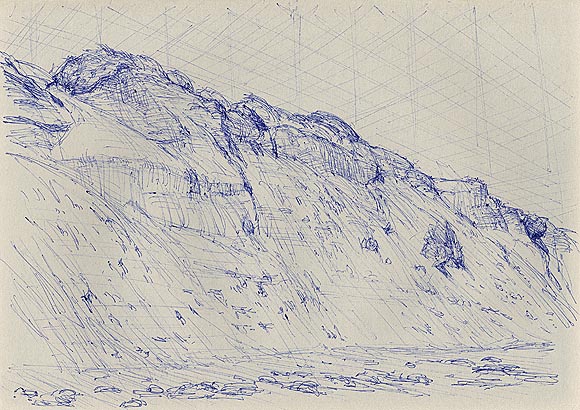
29.5 cm (w) x 21 cm (h), biro on grey paper.This drawing was done on-site at a stretch of West Beach with a long row of sand-hills, which is not easily accessible by road. It is probably because of this, that they are still largely untouched by people, and feel more part of the free wild world, rather than being part of a suburban area. I suppose most beaches feel more part of the free wild world than part of a suburban area anyway, because they are on the edge of a great, mysterious, watery wilderness. Beaches are constantly being “renewed” with each tide, and offer views which could have been very similar (or almost identical) had we been around millions of years ago. There is an immediate freshness about the sea, and yet also a strong timelessness. As with many drawings that I’ve done, I’ve tried to suggest space and structure with repeated lines following the contours of the forms - often drawing a form as if a grid has been drawn over its real surfaces. I have also used repeated structural lines to indicate an invisible b ...more details... |

30.5 cm (w) x 43 cm (h), blue biro on cartridge paper.As with most of my biro drawings, I am mainly concerned with form and structure rather than the tones or colours observed. This drawing shows me with white hair, white skin, white jumper, and white shirt - which looks a bit funny. I was happy with the expression of the various forms within the drawing however - the nose, ear, eyes, shirt collar, jumper over my shoulders, neck, lip, etc. All these forms are expressed without tone, colour, or effects of light. I am not trying to avoid using these qualities as such, but I do want to work efficiently, and I want to concentrate on what is most important. ...more details... |
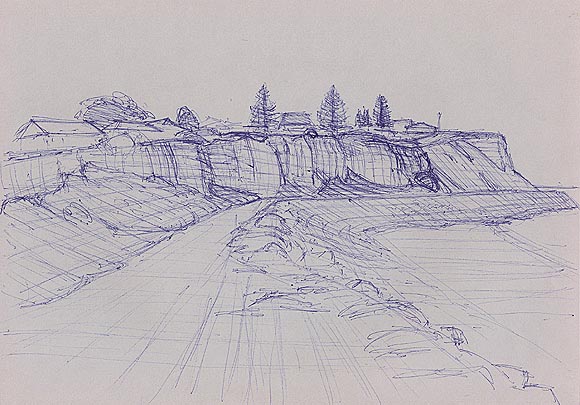
29.5 cm (w) x 21 cm (h), blue biro on grey paper.
|
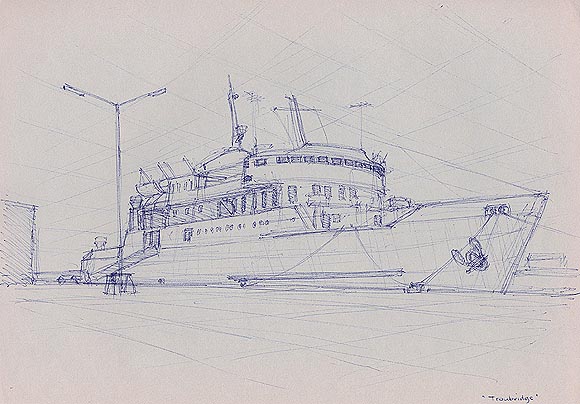
29.5 cm (w) x 21 cm (h), blue biro on grey bond paper.
The Troubridge used to 'sail' to Kangaroo Island from Port Adelaide. I am pretty sure that it carried motor cars as well as passengers. I have applied imaginary grids to the ground, the side of the ship, and to the space in the sky, to help express those features without using tone. |
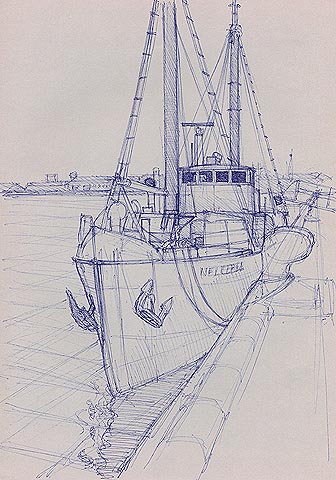
21 cm (w) x 29.5 cm (h), blue biro on grey bond paper.This old boat was part of the Maritime Museum at Port Adelaide. Its details and appearance spoke of years of productive working life on the sea. I wondered about the people who had worked on it, and wondered what stories the boat had been part of. I drew the boat as a form, trying to capture its presence as a large steel object, gently rocking on the Port River. I have applied imaginary grids over the surface of the water and various objects in the drawing, to help express their orientation and general form. ...more details... |
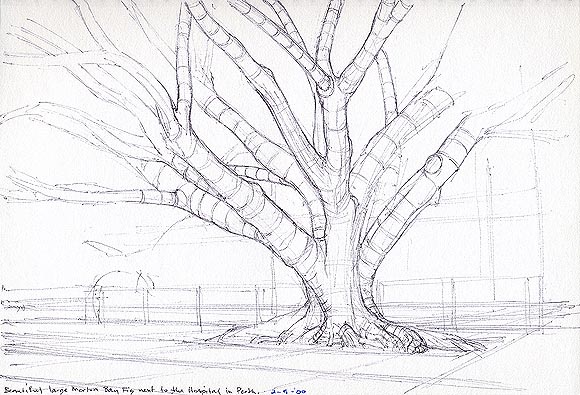
21 cm (w) x 15 cm (h), black biro on acid-free cartridge paper.
|

29.5 cm (w) x 21 cm (h), black biro on acid-free cartridge paper.
|
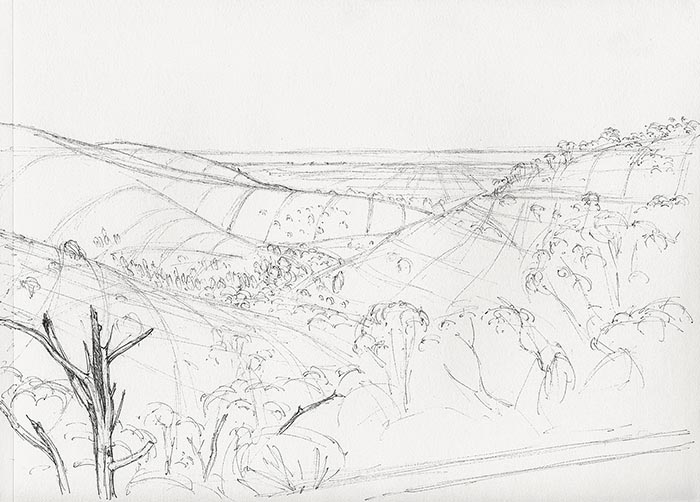
29.5 cm (w) x 21 cm (h), black biro on cartridge paper.
|
Monthly Display - March 2024 - page 1 (of 3) |